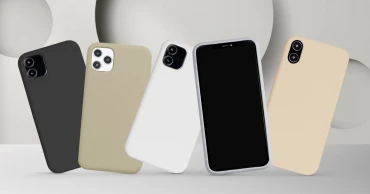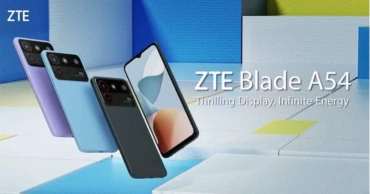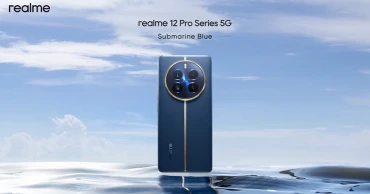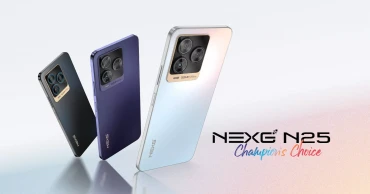Phone review
Best 10 Smartphones Releasing in May 2025
May 2025 is coming to stretch out a long list of smartphones. From budget-friendly to high-end, minimal to gallant, a diverse collection of smartphones will blow the minds of smartphone users. Let’s find out the top smartphones coming from reputed brands in this May.
Top 10 Most Hyped Smartphones Releasing in May 2025
.
Motorola Edge 60 Pro
The Motorola Edge 60 Pro was launched on April 24, 2025, in only a few selected regions worldwide. The phone will be available in the rest of the world in May. Dimensionally the phone is 6.33 inches by 2.88 inches by 0.32 inches with a weight of 186g. For display, it uses a 6.7-inch P-OLED screen that responds to touch at 120 Hz and brightens at up to 4500 nits.
The phone runs on a 4nm Mediatek Dimensity 8350 Extreme chipset, accompanied by a Mali G615-MC6. The primary camera module is a triple camera set that comprises a 50MP wide, a 50MP ultrawide, and a 10MP telephoto shooter, while the front camera is a 50MP wide lens. For battery, the phone uses a 6000mAh Si/C cell with a 90W wired and a 15W wireless charging capacity.
Read more: vivo V50 Lite Review: Does it offer value-for-money
Samsung Galaxy S25
The Samsung Galaxy S25 is rumoured to be launched in May. Dimensionally, the phone measures 6.26 inches by 2.99 inches by 0.23 inches and weighs 163g. It features a 6.66-inch OLED display that refreshes at 120Hz and supports HDR10+, protected by Corning Gorilla Glass Ceramic 2. Powering the device is the 3nm Qualcomm Snapdragon 8 Elite chipset, paired with an Adreno 830 GPU.
The rear camera system is a dual setup, comprising a 200MP wide shooter and a 12MP ultrawide lens, while the front houses a 10MP wide camera for selfies. The phone records video at up to 8K and 30 fps and supports 4K at various frame rates. For battery, the Galaxy S25 is equipped with a 3900mAh cell supporting 25W wired charging.
vivo X200 Ultra
The vivo X200 Ultra is expected to be released on April 29, 2025. Dimensionally, the phone measures 6.42 inches by 3.02 inches by 0.34 inches and weighs either 229g or 232g, depending on the variant. It features a 6.82-inch LTPO AMOLED display that refreshes at 120Hz, supports Dolby Vision and HDR Vivid, and reaches a peak brightness of 4500 nits. The screen is protected by an Armour Glass.
Read more: Tecno Camon 40 Pro Review: Is It Worth It?
At its core, the phone runs on the 3nm Qualcomm Snapdragon 8 Elite chipset, paired with the Adreno 830 GPU, and ships with Android 15 topped by OriginOS 5. The rear camera system is a triple setup that includes a 50MP wide sensor with gimbal OIS, a 200MP periscope telephoto lens, and a 50MP ultrawide shooter, with optional add-on zoom lens capabilities. The front camera is a 50MP wide lens with autofocus.
For battery, the vivo X200 Ultra is powered by a 6000mAh Si/C Li-Ion cell, supporting 90W wired, 40W wireless, as well as reverse wired and wireless charging. Storage options include 256GB with 12GB RAM, 512GB with 16GB RAM, and 1TB with 16GB RAM, all based on UFS 4.1 technology.
iQOO Neo10 Pro+
The iQOO Neo10 Pro+ is gearing up for launch in May. Dimensionally, the Neo10 Pro+ is expected to feature a 6.82-inch display with a 2K resolution, delivering a higher pixel density compared to its predecessor. The phone will be powered by the 3nm Qualcomm Snapdragon 8 Elite chipset, an upgrade over the Dimensity 9400 used in the Pro model.
Read more: Infinix Note 50 Pro Plus Review: Is it a value-for-money midrange smartphone?
For cameras, the Neo10 Pro+ will come equipped with a 50MP primary rear sensor accompanied by an 8MP auxiliary lens, while the front camera will be a 16MP wide shooter. Unlike the Neo10 Pro’s dual 50MP setup, the Pro+ appears to adjust the ultrawide capabilities but boosts the overall display experience.
Motorola Razr Series
Motorola is set to launch the Razr lineup, featuring the Razr Ultra with a 7-inch AMOLED 165 Hz screen, Snapdragon 8 Elite chip, 16 GB RAM, AI Key, and 68W charging. The Razr+ upgrades pack a Snapdragon 8s Gen 3 and keep dual 50 MP cameras. The base Razr uses a Dimensity 7400X with a 50 MP primary camera. All Razr models improve hinge strength, offer colourful designs, and support AI features. Motorola will start pre-orders for the series on May 7, while their shipping will begin on May 15.
Samsung Galaxy F56
The Samsung Galaxy F56, which is allegedly a rebranded Galaxy M56, is rumoured to launch in May. From design to functionalities, the phone may resemble the M56. In that case, it will measure 6.38 inches by 3.04 inches by 0.28 inches in dimensions. For the display, it will have a 6.74-inch AMOLED+ panel with a 120Hz refresh rate and 1080 x 2340 pixel resolution.
Read more: vivo iQoo Neo 10R Review: What’s new?
The phone will run on a 4nm Exynos 1480 processor and Android 15 operating system. In the camera module on the back, there is a 50MP wide, an 8MP ultrawide, and a 2MP macro lens, and on the front, in a punch hole, is a 12MP selfie camera. To supply power while running, a 5000 mAh battery comes with a fast 45W charging system.
OnePlus Nord CE5
The next addition to the OnePlus Nord series, the OnePlus Nord CE5, is rumoured to hit the market in May. Probably a lower midrange phone, the Nord CE5 will have a 6.7-inch fluid AMOLED display, with a capacity for HDR10+ video format, a 120Hz refresh rate, and 1080 x 2412 pixels resolution. The central processing will be done by a 4nm Mediatek Dimensity 8350 chipset, and for the graphical processing, the phone will use a Mali G615-MC6. The primary camera setup will combine a 50MP wide and an 8MP ultrawide lens, while the front camera will be a 16MP lens.
Motorola Edge 60 Pro
The Motorola Edge 60 Pro, announced in April 2025, is set to hit the market soon. A high-end midrange phone, the Edge 60 Pro will feature a 6.7-inch P-OLED display with support for HDR10+, a 120Hz refresh rate, and a 1220 x 2712 pixel resolution. It will be powered by the 4nm Mediatek Dimensity 8350 Extreme chipset, while a Mali G615-MC6 GPU will handle the graphics.
Read more: Best 10 Smartphones Releasing in April 2025
On the back, the phone will offer a triple camera setup combining a 50MP wide lens, a 10MP telephoto lens with 3x optical zoom, and a 50MP ultrawide lens. For selfies, the Edge 60 Pro will include a 50MP front-facing camera.
CMF Phone 2 Pro
The Nothing CMF Phone 2 Pro, announced in April 2025, is expected to launch in mid-May. Positioned as a stylish midrange option, the CMF Phone 2 Pro will feature a 6.77-inch AMOLED display with 1 billion colours, HDR10+ support, a 120Hz refresh rate, and a resolution of 1080 x 2392 pixels.
Powering the device will be the 4nm Mediatek Dimensity 7300 Pro chipset, with graphics processing handled by the Mali-G615 MC2 GPU. The rear camera system will combine a 50MP wide lens, a 50MP telephoto lens offering 2x optical zoom, and an 8MP ultrawide lens. The front camera will house a 16MP wide lens for selfies and video calls.
Read more: itel Power 70 Review: Another budget-friendly gem
OnePlus 13T
The OnePlus 13T is expected to launch soon, bringing a compact yet powerful flagship experience. Measuring 5.94 inches by 2.82 inches by 0.32 inches and weighing 185g, the phone features a 6.32-inch LTPO AMOLED display with 1 billion colours, Dolby Vision, HDR10+, and a 120Hz refresh rate. It peaks at 1600 nits brightness and is protected by Crystal Shield Glass.
At its core, the OnePlus 13T runs on the 3nm Snapdragon 8 Elite chipset with an Adreno 830 GPU. The rear camera setup includes a 50MP wide and a 50MP telephoto lens with 2x optical zoom, while the front houses a 16MP wide camera.
Conclusion
May 2025 is shaping up to be an exciting month for smartphone enthusiasts. From the powerful Motorola Edge 60 Pro and the stylish CMF Phone 2 Pro to the highly anticipated Samsung Galaxy S25 and vivo X200 Ultra, users will find a variety of options across different budget ranges and preferences. Whether it's cutting-edge camera technology, impressive processing power, or bold new designs, these most hyped smartphones promise to push the boundaries of mobile performance. If you're planning an upgrade, May 2025 might just offer the perfect device for your next big move.
Read more: Samsung Galaxy A36 5G Review: A Mid-range marvel with standard features
7 months ago
vivo V30 Lite Review: Know the Pros and Cons
The V series has been the premium flagship line of the reputed smartphone manufacturing brand vivo for several years. The brand also introduced the V Lite lineup to provide a flagship-like experience to mid-range users. vivo recently launched the V30 Lite, the successor to last year's hugely popular V29 Lite on 6th May 2024 in Bangladesh. Let’s take a look at the features, pros, cons, and price of the vivo V30 Lite.
Key Specifications of the vivo V30 Lite
Design and Build Quality
There are several new design features with the new V30 Lite. The core design elements remain the same bearing a rectangular camera housing, vertical sensors, and a punch-hole display. The back panel is made from AG Fluorite glass with injection screening to provide a feather-like pattern. The back panel has thermal sensitivity where it changes color in contact with sunlight.
The dimension of the device comes in at 163.17 mm by 75.81 mm by 7.79 mm (Crystal Black) and 163.17 mm by 75.81 mm by 7.95 mm (Breeze Green) for the two variants. The weight corresponds to 186g (Crystal Black) and 196g (Breeze Green) respectively. It’s a slightly smaller footprint compared to the vivo V29 Lite making it a bit more compact.
Read more: WGP 10400mAh Mini UPS Review: Revamp of a Reliable Backup Device
Ports and buttons are all in their usual positions. Like the ancestor V29 Lite, there is no headphone jack on V30 Lite. The V30 Lite is also IP54 dust and splash-resistant making it more durable.
The Display
The display on the vivo V30 Lite is a 6.67-inch AMOLED panel with a dynamic 120 Hz refresh rate and 1 B colors. Users will enjoy up to 1800 nits of peak brightness in a space of 88.3% screen-to-body ratio.
The resolution of its display comes in at 2400 by 1080 pixels with 394 ppi density. Additional features like 107% color saturation, 100% DCI-P3 color gamut, and E4 light-emitting materials make this display a touch above the rest.
Read more: realme P1 5G Review: New Mid-Range Line-up
considering overall quality, the V30 Lite takes the edge over the V29 Lite. Even among its competitors, the V30 Lite provides better results than the Samsung Galaxy A55 or Oppo Reno 11 F. The only device to edge over the V30 Lite at this price is the Xiaomi Redmi Note 13 Pro.
The Camera
There’s a dual camera setup on the vivo V30 Lite. The main sensor is a 50 MP f/1.8 with PDAF and the secondary sensor is a 2 MP f/2.4 depth sensor. The front features a generic 8 MP f/2.0 sensor.
From the spec alone, the V30 Lite falls short of its competitors as most devices at this price range come with a triple camera setup. The V29 Lite also had a triple camera setup with the main sensor being a 64 MP one.
Read more: Portable AC Buyer’s Guide for 2024: Everything You Need to Know
But speaking of the actual performance, the V30 Lite produces on-par results. Pictures came out sharp with great contrast and neutral color in daylight. There was no forced color reproduction which the A55 or the Redmi Note 13 Pro suffers from. The quality was also similar in low light with better exposition in the dedicated night mode.
The depth sensor helps in taking great portrait shots. Users can tweak the bokeh effect after taking a shot which might be handy in different situations. The front camera also produced passable results with good details and dynamic range.
The videography on the vivo V30 Lite is limited to 1080P at 30 fps. It produced decent results using the included EIS feature.
Read more: Xinji Cobee CA1 Review: Waterproof Smartwatch to Monitor Health and Fitness
Processor and Performance
The processor on the V30 Lite is the Snapdragon 685 based on a 6 Nm architecture. It is a point of contention given that all the competitors including the previous gen V29 Lite have a better processor.
The processor features an octa-core architecture with 4 × 2.8 GHz and 4 × 1.9 GHz locked clock speed. The Antutu score of the CPU comes in at 346350 and the Geekbench score is 473 (single-core) and 1510 (multi-score).
In terms of performance, the V30 Lite is a daily task smartphone at best. Gaming isn’t its forte as titles like PUBG and Genshin Impact were barely playable in moderate settings. There’s also the thermal issue with prolonged gaming.
Read more: Xiaomi Redmi Turbo 3 Review: A New Contender in Performance-oriented Smartphones
Considering the price, the performance of the vivo V30 Lite isn’t all that great. Alternatives like Galaxy A55 (Exynos 1480), Redmi Note 13 Pro (7s Gen 2), and Reno 11 F (Dimensity 7050) all bring better performance in a similar price range.
Software
The V30 Lite is running Funtouch OS 14 based on Android 14. It has its fair share of bloatware but the overall user experience was moderate with fast navigation and app switching.
Battery and Charge Time
The battery on the vivo V30 Lite is 5000 mAh. The device comes with 80W FlashCharge which can take the device from 0 to 80% in 30 minutes. With moderate and casual use, expect to get around 6 to 7 hours of screen time from the device.
Read more: 7 Best Smartphones Being Released in May 2024
Pros and Cons of vivo V30 Lite
Pros
- AMOLED panel with 120 Hz refresh rate - 80W FlashCharge support - Decent main camera - IP54 dust and splash resistant - Color changing back - AG Fluorite protection - Comes with Android 14.
Cons
- Average Performance - Plastic frame design - No Gorilla glass protection on display- No reverse or wireless charging capacity- No optical zoom camera - No 4K video footage recordings support- No Gyro-EIS support- No MicroSD card slot- No audio jack- No 5G support - Outdated USB Type-C charging port.
Read more: Meizu 21 Review: A Detailed Look at the Latest Flagship Killer
Official Price of vivo V30 Lite in Bangladesh
The V30 Lite is available in the 8/256 GB variant in Bangladesh. The price of the V30 Lite is 32,999 BDT. However, the price is subject to change.
Verdict
The V30 Lite can be best termed as a mixed-bag smartphone. It brings an interesting design with gimmicky features, great display, and great battery life. But at the same time, it grossly falls short in the performance department.
If you’re looking for a more capable device in terms of performance and camera capabilities then the A55 and Redmi Note 13 Pro can be a better choice. Other than that, the vivo V30 Lite can be good for those looking for a stylish smartphone for casual use.
Read more: Motorola Moto G34 Review: A Budget-friendly 5G Phone with Powerful Processor
1 year ago
Most Anticipated Smartphones Coming in March 2024
February has been relatively slow in terms of smartphone releases. Several Chinese smartphones made their international debut in February. But it was mostly limited to budget and mid-range options. March however, promises some highly anticipated global flagship releases in addition to the usual budget and mid-rangers. Let’s check out the best upcoming smartphones in March 2024.
Most Hyped Smartphones Coming This March
Tecno Camon 30 Premier
Tecno is gearing up to launch their flagship of the year – the Camon 30 Premier sometime mid-March. The device was officially announced on 27th February with several surprising specs.
Camon 30 Premier boasts a stunning 1264 by 2780 pixels LTPO AMOLED panel with 120 Hz refresh rate. The near uniform front bezel accounts for about 89.9% screen-to-body ratio with a 451 ppi.
Camon 30 Premier will be powered by the latest MediaTek Dimensity 8200 Ultimate with a single 12/512 GB configuration.
However, the exciting change is in the camera department. Tecno has gone with an all 50 MP sensor setup (PolarAce Imaging System). Three of them on the back and one on the front. The back camera consists of a wide-angle main shooter, a periscope telephoto, and an ultrawide sensor.
In addition to the 5000 mAh battery, the device will support up to 70W wired fast charging.
Read more: Balmuda Phone Review: Is This Compact Smartphone Worth Buying?
Asus Zenfone 11 Ultra
Asus’s Zenfone 11 Ultra has been officially slated for launch on 14th March 2024. From what is known so far, the 11 Ultra is going to be a close rival to their highly successful ROG series.
The 11 Ultra features a 6.78-inch LTPO AMOLED panel with 1080 by 2400 pixels at 388 ppi and an 88.2% screen-to-body ratio. There’s also a 144 Hz refresh rate and HDR10 for seamless content consumption.
The device will be powered by the latest Qualcomm SM8650-AB Snapdragon 8 Gen 3 with storage options of 12/256 GB and 16/512 GB.
On the camera front, users will be getting a 50 MP main, 32 MP telephoto, and a 13 MP ultrawide sensor. The front will feature a 32 MP shooter.
As for the battery, the 5500 mAh capacity can be topped up with 65W wired, 15W wireless, and 10W reverse wired charging.
Read more: Infinix Hot 40 Pro Review: Budget-friendly Phone with Premium Features
1 year ago
ZTE Nubia Neo 5G Review: A Budget-friendly Gaming Phone
Gaming smartphones often come with a hefty price tag due to their high-performance processors and advanced cooling systems. However, some brands are offering budget-friendly phones designed for gaming. In this wave, ZTE brings a gaming-centric device Nubia NEO 5G at an affordable price point. Let’s take a look at the key specs of this device.
Features and Specs of ZTE Nubia Neo
Design
The ZTE Nubia Neo is turning heads with its sleek design and lightweight build. Coming in at 163.7 mm by 75 mm by 8 mm dimension and weighing just 192 grams, it's easy to tote around.
One of its standout features is its nearly borderless display. It gives users a screen-to-body ratio of about 85.5%. This means users get more screen space on its display.
As for durability, while the exact materials used aren't explicitly mentioned by the company, the Nubia Neo feels sturdy and well-built. Its back panel and frame give off a premium vibe, with a nice finish to top it off.
Read more: ZTE Nubia Z60 Ultra Review: A Heavy-Duty Flagship Gaming Device
The Nubia Neo scores points with its ergonomic design. The buttons are placed conveniently for easy access, and unlocking feels smooth with the side-mounted fingerprint sensor. Plus, it's comfortable to hold, even for one-handed use.
Display
The ZTE Nubia Neo packs a 6.6-inch IPS LCD screen, which boasts vibrant colors and smooth visuals with 1080 by 2408 pixel resolution. Thanks to its 120Hz refresh rate it promises an immersive viewing experience. The phone gives a crisp picture with about 400 pixels per inch. That means sharp, detailed visuals for viewing pleasure, all wrapped up in a sleek 20:9 aspect ratio.
With minimal bezels, users are getting almost all screens. And with a super smooth 120Hz refresh rate, scrolling and animations are buttery-smooth.
When it comes to colors, the Nubia Neo's LCD tech brings accurate and vibrant hues to the table, ensuring your content pops just right. Plus, you can comfortably view it from different angles thanks to good viewing angles.
Read more: realme GT5 Review: A gaming phone with high capability
For those sunny days, there might be an anti-glare coating to help you see your screen better outdoors, along with the auto-brightness adjustment to keep things just right no matter where the users are.
Camera
The ZTE Nubia Neo has a fancy dual-camera system on its back. One lens packs a whopping 50 megapixels with a wide f/1.8 aperture, while the other is a 2-megapixel (f/2.4) depth sensor. Together, they make for some seriously detailed and clear shots.
With that hefty megapixel count, it features high-resolution pics. And thanks to the wider aperture that supports better light intake, meaning the low-light photos will look sharper along with cool blurry background effects in portrait mode.
The camera isn't just about stills, though. It supports features like HDR and panorama mode, giving your shots more pop and letting you capture wider angles. Plus, there's image stabilization to help smooth out any shaky-handed shots or videos.
Read more: DOOGEE V31GT 5G Rugged Phone Review: Sturdy mid-range gaming device
Speaking of videos, the front and rear cameras of Nubia Neo can shoot 1080p footage at 30fps. And don't worry about those videos getting too shaky—there's video stabilization onboard to keep things nice and steady, even if there's some movement.
And there is a front camera which is an 8-megapixel (f/2.0) shooter, perfect for snapping selfies or hopping on video calls.
1 year ago
ZTE Blade A54 Review: An Entry-level Smartphone Below Tk10000
ZTE is known for being the parent company of Nubia, the subsidiary which produces high-end gaming smartphones. However, ZTE uses its proprietary brand name for all sorts of different smartphones as well. Recently, the brand launched the Blade A54 in November 2023. The entry-level smartphone brings a design overhaul with some interesting quirks. Let’s have a detailed look.
Key Specs of ZTE Blade A54
Design and Build Quality: Revamped Design with Same Old Plastic Build
At first look, the A54 looks much like the Realme GT 5 with its large end-to-end rectangular camera housing on the back. ZTE had a complete design overhaul on the A54 from the A53 as has been the case with all their models. The rectangular camera housing has a glossy finish whereas the back itself has a matte tone.
The smartphone has a 164 mm by 75.8 mm by 8.5 mm dimension with a plastic build all around. That brings the weight to around 185 g. The A54 keeps the 3.5 mm headphone jack and the dedicated microSD slot in place as is widely seen in this price segment.
Read more: Honor X6a Review: A minimalist budget-friendly phone with standard features
The plastic material is durable with drop and scratch resistance. The smartphone is available in three colorways, blue, gray, and lilac.
The Display: IPS LCD Panel with 90 Hz Refresh Rate
The display on the A54 is a 6.6-inch IPS LCD panel with a 90 Hz refresh rate. The water drop style notch and the large chin is a usual feature in any budget-friendly smartphone. The HD+ resolution comes in at 720 by 1612 pixels and 267 ppi density. The display fetches around 84.2% screen-to-body ratio.
There’s nothing really special about the display other than that it can get relatively bright indoors. The color reproduction is satisfactory with a slightly cooler tone. Viewing angles are passable with color shifts at extreme angles. Outdoor legibility isn’t all that great with the panel struggling under direct sunlight.
Read more: Infinix Smart 8 Review: Affordable Excellence in Entry-Level Smartphones
The Camera: Dual Camera with a Single Usable Lens
The main camera on the A54 is a 13 MP one with AF. The supporting sensor is a 0.08 MP auxiliary sensor which unsurprisingly, does nothing. And if an auxiliary sensor wasn’t a marketing gimmick enough, there’s a camera sensor-like design on the housing which is just printed graphics. Such design choices can be distracting for potential buyers.
The front features a 2 MP selfie shooter which ZTE claims to be “interpolated to 5 MP”. What it means is that post-processing can enhance the image up to 5 MP quality. The results aren’t all that great even in well-lit conditions. It’s disappointing considering even the most stringent entry-level smartphones these days come with at least 8 MP front shooters.
The performance from the main camera was as expected from a budget-friendly smartphone. Pictures taken under direct sunlight had good details but the dynamic range was average at best. Pictures taken at night or indoors had exposure issues and noticeable grain here and there. The warm tone pop was missing in photos captured by the A54. However, this feature is common on the average basic-level smartphones.
Read more: Lava Benco V90 Review: New Low Budget Smartphone in Bangladesh
The videography on the Blade A54 is rated at 1080P at 30 fps. But without any external stabilization, videos came out choppy and shaky.
1 year ago
realme 12 Pro Plus Full Review: Is It Worth Buying?
realme has established itself as a brand renowned for blending innovation with affordability in the smartphone industry. With the debut of the realme 12 Pro Plus on January 29, 2024, a new chapter unfolds, challenging the notion that top-tier features are exclusively reserved for high-priced models. Let’s explore the extensive features of the realme 12 Pro Plus, emphasizing its premium qualities without compromising on its accessible price point.
Key Features and Specs of realme 12 Pro+
Design
The realme 12 Pro Plus stands out with its sleek design and premium features. Measuring 161.5 mm by 74 mm by 8.8 mm (6.36 x 2.91 x 0.35 in), it strikes a balance between compactness and usability. The phone's vegan leather back, complemented by a round camera module, exudes sophistication.
Its golden fluted bezel and accents, inspired by luxury watches, lend it a touch of elegance. Designed in collaboration with renowned French watchmaker Ollivier Savéo, known for his craftsmanship with prestigious Swiss brands, the phone reflects a blend of artistry and technology.
With a convenient layout featuring volume and power buttons on the right side, and essential ports and speakers neatly arranged at the bottom, usability is seamless. Additionally, the scratch-resistant rear and screen protector offer peace of mind, ensuring the phone remains pristine with daily use.
Read more: iQOO Neo 9 Review: A Flagship Grade Mid-Range Smartphone
Display
The realme 12 Pro Plus boasts a stunning 6.7-inch OLED display with a 120Hz refresh rate, providing smooth and fluid visuals. With a resolution of 2412 by 1080 pixels (FHD+), the screen delivers crisp and clear images. It offers around 394 PPI density
It covers 100% of the P3 color gamut, ensuring vibrant and accurate colors. With a global maximum brightness of 800 nits and a local peak brightness of 950 nits, the display remains visible even in bright sunlight. Additionally, it features a 0.55mm secondary tempered high-strength glass for added durability and protection.
The display holds TÜV Rheinland Strobe-free and Low Blue Light Certifications, reducing eye strain during prolonged use. Supporting HDR10+, it offers enhanced contrast and dynamic range for an immersive viewing experience. With a 240Hz touch sampling rate, the screen responds swiftly to touches and gestures, enhancing usability.
Read more: Xiaomi 13T Pro Review: The flagship killer is back
Camera
The realme 12 Pro Plus features an impressive camera setup tailored to meet diverse photography needs.
Anchoring the rear setup is a 50MP (f/1.8) IMX890 sensor with Optical Image Stabilization (OIS) and 2X in-sensor zoom, delivering sharp and stable shots. Complementing this is a 64MP (f/2.8) periscope lens for long-range captures and an 8MP (f/2.2) ultra-wide lens for expansive scenes.
The front camera, equipped with a 32MP (f/2.4) sensor, ensures detailed and crisp selfies. Notably, the camera captures colors accurately with minimal correction, offering natural-looking tones.
The portrait mode, with 3x zoom and adjustable aperture, enables users to achieve desired background blur levels. Additionally, the Pro mode allows for manual adjustments of ISO, shutter speed, and more, catering to advanced users. The device also offers a 120x zoom option, albeit with limitations at extreme levels.
Read more: HONOR 70 5G Review: Is it worth high midrange price
For video recording, users can shoot in 4K at 30fps with the rear camera and 1080p at 30fps with the front camera, ensuring high-quality video content creation.
1 year ago
Walton NEXG N25 Review: A Budget-friendly Smartphone with Standard Features
Walton is a widely renowned feature and smartphone manufacturer in Bangladesh. The brand has expanded its portfolio from home appliances to smartphones and has made its distinct mark as a local brand. Particularly, their NEXG series stands out for its design and durability for affordable price ranges. The brand recently launched the NEXG N25 on 21st January 2024. Let’s look at the Walton NEXG N25 phone's detailed review.
Key Specifications of Walton NEXG N25
Design and Build Quality: A match of aesthetics and durability
The NEXG N25 moves away from the traditional Walton design elements to embrace something new. The new design looks something reminiscent of the iPhone or the iQOO Neo series. The smartphone is made of plastic with a refracting frosted finish on the back and a brushed chrome look on the frame.
The dimension comes in at 164.5 mm by 76.1 mm by 8.65 mm with 196 g weight. There’s a sizable front chin on the N25 which might look out of place by 2024 standards. But considering the price range, it's an understandable tradeoff. On the positive end, there’s IP52 water and dust resistance on the N25.
Read more: Tecno Spark 20C Review: Standard phone under 15000 TK
Ports and buttons are placed in their usual location. There’s dual sim support on the N25 with a dedicated micro SDXC slot. There’s also a 3.5 mm headphone jack at the bottom along with the Type C port.
The Display: IPS LCD with 90 Hz refresh rate
There isn’t much to rave about the displays of budget-friendly smartphones. As usual, the N25 features an IPS INCELL LCD panel with a punch-hole camera on the front. The 6.6-inch panel has 720 by 1612 pixels for an HD+ resolution. In addition to the 90 Hz refresh rate, the panel boasts a 180 Hz touch sampling rate and 400 nits of peak brightness. The exact pixel count and screen-to-body ratio on the N25 couldn’t be confirmed.
For an LCD panel, the display has decent brightness, color reproduction, and viewing angles. The 90 Hz refresh rate and the color vividness alleviates the overall interaction with the display.
Read more: Honor 90 Lite Review: Performance within Budget
The Camera: 50 MP AI Triple Camera
Like most smartphones in the entry-level segment, the number of camera sensors is usually a marketing bait. The case is similar with the N25 as well. There’s a 50 MP f/1.8 main sensor with AF, and PDAF. Walton has also included basic features like BSI, Antibanding, and Touch Focus. But that’s about it when it comes to the back camera as the other two included sensors are a 2 MP macro and an unrated AI camera.
The front features a usable 8 MP f/2.0 sensor for decent enough selfies.
The camera performance, similar to other NEXG smartphones, is a hit-and-miss at times. The camera was able to produce decent results in good lighting with a slightly greenish tint. The details and dynamic range were also satisfactory. But under harsh lights, the camera fails to properly expose the subject and the background. The portrait mode also leaves much to be desired with edge detection errors here and there. Nighttime photos are riddled with grains and noises. The night mode however helps a bit with decent artificial lights.
Read more: Infinix Note 30 5G Review: Know the Pros and Cons
The videography is limited to 1080P without any form of stabilization onboard the device.
Processor and Performance: Decent Daily Driver with Bloatware Issues
The processor on the N25 is a Unisoc Tiger T616 2.0 GHz octa-core one. It is coupled with Mali-G57 MP1 GPU. On paper, the T616 is a basic entry-level Octa-core processor that is best suited for casual day-to-day use. The N25 also comes with 4GB RAM and 128 GB of internal storage. There’s an additional 4 GB of virtual RAM that can be accessed from the storage.
Games on the N25 performed below par. Titles like Free Fire, PUBG, and Asphalt 9 had a lot of flickers and stutters to make it a smooth experience. On the other hand, 2D and less graphics-intensive games like Temple Run 2 ran smoothly.
Read more: Symphony Helio 80 Review: Is the hype justified?
The N25 is using Dido OS based on Android 13. It’s a third-party OS with its own set of bloatware, which thankfully, can be uninstalled. The OS has some useful features like quick navigation through Smart Touch and ring light notifications. There are three distinct ring lights blended into the three back cameras which act as a notification light.
The processor and the RAM would have been better on the N25 as competitors like Xiaomi offer Snapdragon equivalence at this budget-friendly range.
Battery and Charge Time
The NEXG N25 comes with a 5000 mAh battery. The low processing power allows for a good battery life which would comfortably last all day in a single charge. There’s a 10W charging brick included in the box. However, the device can support up to 18W charging.
Read more: vivo Y17s Review with Price in Bangladesh
Pros and Cons of Walton NEXG N25
Pros:
- Good Display - Great Build Quality - Ring light notification - Great battery life - IP52 protection.
Cons
- Subpar performance - Average camera.
Read more: Xiaomi Redmi Note 13 Review: What are the key upgrades?
Price of Walton NEXG N25 in Bangladesh
The Walton NEXG N25 smartphone is available for 13,999 BDT in Bangladesh.
Verdict
The NEXG N25 offers a good package considering the competition in the budget-friendly segment. An inclusion of 6 GB RAM, a periscope sensor, and a slightly more powerful processor could make the device a strong competitor. However, the smartphone still shines in its display, design, and build quality. For what it is worth, the Walton NEXG N25 is best suited for those looking for a casual daily driver for processor-easy tasks.
Read more: Tecno Spark 20 Review: Budget-friendly phone with a smart look
1 year ago
OnePlus 12 Review: Fastest Android Experience?
OnePlus has long since passed its prime from being the “flagship killer” in the Android space. It slowly shifted from offering value-for-money smartphones to full-on flagships with secondary mid-range iterations. OnePlus launched the OnePlus 12 on December 11, 2023, making it the last big release of 2023. But with all that it has under the belt, OnePlus is aiming for the fastest Android experience in 2024.
Key Specifications of OnePlus 12
Design and Build Quality: Same Old Design with a Dash of Character
By all means, the OnePlus 12 looks exactly the same as its predecessor, the OnePlus 11. The merging round camera housing and all sides curved front reminisce the somewhat iconic design introduced with the OnePlus 10. The front glass features Gorilla Glass Victus 2 with the rear featuring standard Gorilla Glass. The back now has a marble-like finish with a glossy inlay on the camera housing.
The device comes in at 164.3 mm by 75.8 mm by 9.2 mm and has a hefty weight of 220g. Ports and buttons are all standard as usual. The power button, volume rockers, sim slot, and alert slider are all placed in their desired position. The phone comes with IP65 water and dustproofing rather than the standard IP68 seen on most flagship smartphones. In a sense, the design of the OnePlus 12 adds a minor refinement over their proven strategy.
Read more: iQoo 12 Pro Review: Flagship phone for gamers
The Display: A New Standard for Brightness
OnePlus has recently been marred with green line controversies on its panel. And it seems like OnePlus has decided to completely overhaul the display tech with the OnePlus 12. The 6.82-inch LTPO AMOLED ProXDR panel comes with 1B colors, 120Hz refresh rate, Dolby Vision, and HDR10+ support. OnePlus has used a diamond pixel layout compared to the traditional square layout. It has a 1440 by 3168 pixels resolution with 510 ppi density and a 19.8:9 aspect ratio. The all-around curve gives the panel about 90.8% screen-to-body ratio. The display also supports 100% Display P3 and 10-bit color depth.
What’s interesting here is the brightness of the panel. The typical brightness holds at 600 nits and up to 1600 nits at HBM. But the panel can crank up to 4500 nits in peak mode. That’s more than any smartphone out there in the market by a long mile. And its something that won’t be exercised even in the harshest sunlight. On the flip side, the panel supports 2160 Hz PWM dimming for ultra-low brightness for nighttime use. All things considered, the display is definitely a highlight for the OnePlus 12.
Read more: vivo X100 Pro Review: A New Standard for Camera
The Camera: Same Old OnePlus
The camera has consistently been a point of contention with OnePlus smartphones. And unfortunately, things haven’t really changed much. There’s a triple camera setup on the OnePlus 12 with the main camera being an updated 50 MP sensor. It has an f/1.6 aperture and a 23mm wide-angle opening. The additional sensors are a 64 MP, f/2.6, 70mm periscope lens with up to 3x zoom and a 48 MP, f/2.2, 14mm, 114˚ ultrawide shooter. The front camera is a 32 MP, f/2.4, 21mm wide-angle shooter.
All the sensors are stacked with features like multidirectional PDAF, OIS, and gyro-EIS. OnePlus has been partnering with Hasselblad for a customized color calibration. The pictures on the OnePlus 12 can be best described as slightly better than that of the 11 with somewhat similar flaws. Images have slight exposure issues with an average dynamic range. The camera is also post-processing heavy to the point that what you see on the screen grossly differs from what’s processed after the shutter click.
The videography of the rear cameras stay the same at 8K@24fps, 4K@30/60fps, 1080p@30/60/240/480fps. The selfie shooter can capture a maximum of 4K footage at 30fps. However, the exposure issue and low light videography leaves much to be desired from the Oneplus 12.
Read more: Google Pixel 8 Pro Review: Is this the best Android phone of 2023?
1 year ago
iQOO Neo 9 Review: A Flagship Grade Mid-Range Smartphone
iQOO saved up a big surprise till the very end of 2023. The Vivo subsidiary launched the much-hyped iQOO Neo 9 on 27th December in China. The smartphone is scheduled for a mid-February launch globally. For the time being, the smartphone has garnered a lot of attention and buzz among the users. So what’s the hype all about? Let’s find out.
Key Specifications of the vivo iQOO Neo 9
Design and Build Quality
The iQOO Neo series is known for its drastic design jumps in each iteration. The Neo 9 is also no different. There’s virtually no similarity between the Neo 8 and Neo 9 except for the fact that both of them have a plastic build.
The Neo 9 has a flat front and back with two large separate housings for the two camera sensors. The dimension of the smartphone comes in at 163.5 by 75.7 by 8 mm or 8.3 mm. The 8.3 mm version has a faux leather finish in bright red and contrasting white. It's probably the best looking one among a choice between black and blue. The faux leather variant weighs at 196 g whereas the standard model comes in at 190 g.
The ports and buttons are carried on from the Neo 8 with the SIM slot taking its place beside the Type C port. There’s also an IR blaster along with the secondary noise cancellation mic at the top. Other than that, the minimal front bezel and even weight distribution make for a premium mid-range smartphone.
Read more: realme GT5 Pro Review: High-performance or Hype?
The Display
The display on the Neo 9 is a 6.78 inches LTPO AMOLED panel with standard features like 1B colors, 144 Hz refresh rate, HDR10+ support, and 1400 nits of HBM. What’s interesting here is the inclusion of an LTPO panel. Even many high-end smartphones these days don’t come with this feature. Needless to say, it’ll definitely help conserve a lot of battery on the 1260 by 2800 pixels and 453 ppi density.
The display also has the new PWM dimming feature. It essentially dims out the blacks entirely by varying the electric pulse on the individual LEDs. The result is striking low brightness in dark environments and true black contrast.
The bezel on the center punch-hole display is very minimal with the lower chin protruding ever so slightly. The slim trim helps to keep the screen-to-body ratio at 89.7%. The bottom line, it's an amazing display that seriously punches above its price.
Read more: Motorola Edge 40 Neo 5G Review: What’s New?
The Camera
There’s a dual-lens camera on the Neo 9 with the main camera being a 50 MP f/1.9 wide angle and 1/1.49" aperture sensor. The secondary shooter is 8 MP, f/2.2 with a 119-degree field of view. Both the main and the secondary camera uses IMX sensors from Sony for improved camera performance.
1 year ago
realme GT5 Pro Review: High-performance or Hype?
In a bold move into the high-end market, realme introduces the GT5 Pro as a "dual-engine flagship," emphasising both impeccable performance and exceptional imaging capabilities. Launched on 16th December 2023, this smartphone aims to redefine realme's reputation in mid-range segments. From its robust design to impressive hardware, GT5 Pro marks realme's foray into the premium smartphone arena. This review explores every facet of the GT5 Pro.
Key Features and Specifications of realme GT5 Pro
Design
The realme GT5 Pro comes with a curved screen. The screen minimises borders (1.36mm on the sides, 1.94mm at the bottom). Weighing 218 to 224g, this device’s dimensions are 161.7mm by 7.51mm by 9.2mm.
The phone's quality is evident in its materials, featuring a super hard aluminium middle frame with 43% higher yield strength than standard titanium alloys.
The camera module features a champagne gold aluminium alloy ring. Its USB Type-C port supports fast charging. Notably, it lacks a headphone jack, embracing wireless audio trends.
Read more: iQoo 12 Pro Review: Flagship phone for gamers
The dual-SIM tray supports nano-SIM cards, but there's no microSD card support. An infrared port enables the phone to function as a remote control. With an IP64 rating, the GT5 Pro resists dust and water splashes, enhancing durability for outdoor use.
This device is available in several colour variants, such as, Black, White, and Orange. White and Orange options feature nano-leather, while the Black variant uses AG glass for a classic look.
Display
The realme GT5 Pro boasts a 6.78-inch screen that strikes a balance between ample viewing space and handheld comfort, catering to various activities like browsing, gaming, and multimedia consumption.
The screen utilises BOE's S1 flexible screen technology, with a resolution of 2780 by 1264 pixels (1.5K), ensuring sharp and detailed visuals without excessive battery drain.
Read more: vivo X100 Pro Review: A New Standard for Camera
In terms of colour accuracy, the GT5 Pro delivers quite natural colours, particularly noticeable in high-resolution photos or videos. The display's peak brightness is about 450 nits and ensures visibility in bright outdoor conditions. The manual maximum brightness is 1000 nits, with a global maximum of 1600 nits, beneficial for HDR content and detailing in various lighting conditions.
The 144Hz high refresh rate enhances user experience, especially in fast-paced gaming, with adaptive adjustment from 0.5Hz to 144Hz using 8T LTPO technology, optimising performance and power consumption.
For eye comfort, the GT5 Pro features 2160Hz high-frequency PWM dimming at low brightness, minimising screen flicker and eye strain. At higher brightness, it switches to DC dimming, reducing the risk of eye discomfort. The low SVM (Screen Flicker Metric) value of
1 year ago



















